Unhand me good reason and pour me another scotch ...
quickly! I stand before a blank canvas, brush loaded color mixed ... and
mind blank. What to paint? Can't think of a thing. Suddenly a lateral thought
(just a little water - don't fill it up ... and no ice. Thank you!) . Why
not a painting on lateral thought? Who had the first lateral thought? Adam?
Never! No Alexander the Great maybe with the cutting of the Gordian knot? Has that been
painted? No you say! Well lets go. Get me the book on Alexander.
Mmm ....
'The Gordian Knot 'Three sayings used by pompous orators for hundreds of
years as classical figures of speech are "as rich as Croesus",
"I came, I saw, I conquered", and "to cut the Gordian Knot".
All three had their original home in Türkiye. (Is that how they spelled
it?) The first applied to a Lydian King; the second was said by Julius
Caesar after a battle in Asia Minor, 47 B.C., in which he defeated Pharnaces
II, King of Pontus; the last refers to a legend of ancient Phrygia. The
city of Gordium, now called Gordion and is about a hundred miles west of Ankara.
It was the capital of ancient Phrygia. One of its rules was a peasant named
Gordius, who gave his name to the city after fulfilling an oracle of Zeus.
Though I spent some time in the dusty cradle of man ... the middle east, still, I am going to have to do some research here. A street in some ancient city in Persia - one hundred miles west of Ankara? What would it look like?
THE STORY
The father of gods had ordained that when it
came time for the people to select a king, they must choose the first person
to ride up to the temple of Zeus in a wagon. Gordius innocently fulfilled
the oracle and was made king. (The system might be an improvement over
a methods of election held today. Certainly it would eliminate political
campaigns). In any event, Gordius seems to have done very well. One of
his first acts was to dedicate his wagon to Zeus and to place it near the
temple, the yoke tied to the pole by an intricate knot of cornel bark.
( Ah.. good, waggon pole and knot- can paint that) Another oracle declared
that anyone who succeeded in untying the knot would be the conqueror of
all Asia. The knot stayed tied until the arrival of Alexander. Then, as
everybody knows, he cheated on the oracle by cutting the knot with his
sword instead of untying it. Zeus honored his initiative by making the
prophecy come true. Note to myself: don't show the cutting. Just the knot
the sword the post and the waggon. Any of that scotch left? Damn I was
just getting started ....
Next day ... how I paint does count. What I
paint maybe important. When I traversed the long corridors of my school (on
the way to the headmaster's office) the paintings I passed had a remarkable
effect on me. I could become a hero, a villian, or whatever. My imagination
soared beyond the classroom, beyond the impending punishment and I remember
it well. I remember barely a glance at the colorful Mondrian and the two
two dimensional Picassos'. I saw only the Rubens, Titians and a Gerome that communicated
to me something more of the human condition. Something to lift and sustain me. Now I
look at Alexander my aim becomes to paint for the person in the same position
as I was in that corridor - with the addition of a lateral thought. Whatever
good that will do. Anyway I have started.... all these words. Ugh! Now
I must make a start!
The canvas is 52" square and I have found
a background I can manipulate.
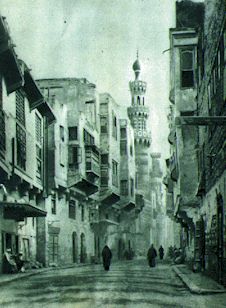 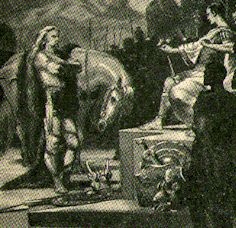
Fig. 1 Fig
2
Fig. 1 was one I noticed in an old black and
white encyclopedia and kept for just such a rainy day. It is a view of a street
in Cairo 1890 ... but I think I can alter the archeticture, adapt it ... it has the feel of antiquity.
Now for the central figure. I found this distant
image in my files. (Fig. 2) Being a fan of English author David Gemmell
I like the 'Dark Prince' notion of Alexander. Heroic, flawed, naked, helmeted
and a battleground between the dark and the light, brutality and compassion,
good and evil. With a few adjustments this figure will do nicely. The horse
is good as well!
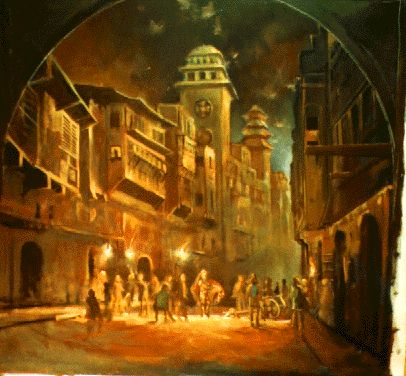
Fig. 3
Rough it in ... I need artificial light (torches).
Composition ... simple square within a square. Disguise large square with
and arch.
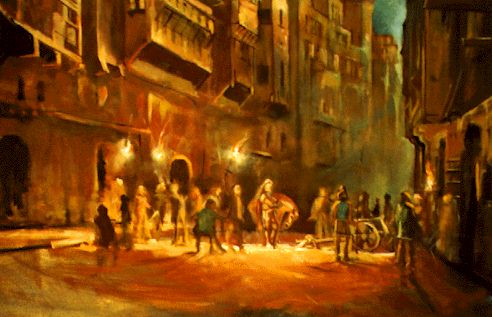
Fig. 4
Scattered groups of figures. Light from two major
sources, sky and torches. The two must join somewhere ... solve that later
... or hope it will solve itself (ha ha ... quick another scotch ... just
a small one then)
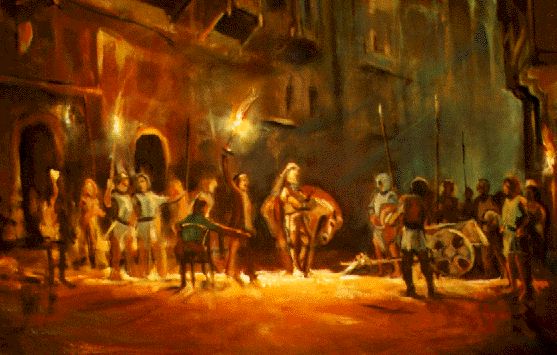
Fig. 5
More work on the figures ... tighten it up.
Seemed to have fixed the main areas of interest. Light buildings - dark
sky... and dark sky light buildings *try both. Alexander controlled naked
agression, good. Keep him separated and darken the area behind.
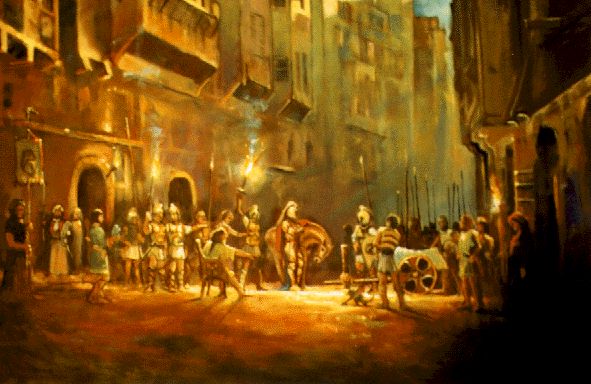
Fig. 6
Add more people spears, monkey, waggon, (research Greek armour) breastplates, short swords, tunics? Ah well. Still see
problem jouning sky and ground ... tomorrow then
|